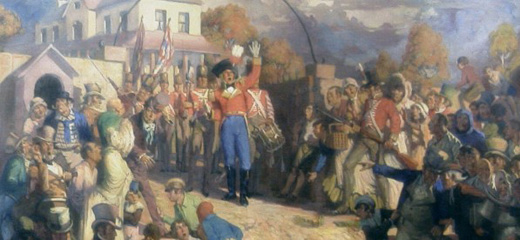PRINCIPAL COMBATANTS: Australian liquor interests and their military supporters vs. colonial governor William Bligh
PRINCIPAL THEATER(S): Sydney, Australia
MAJOR ISSUES AND OBJECTIVES: Bligh, with typical bluster, sought to rule Australia with an authoritarian hand; the local liquor interests and military commanders sought to deny his authority and have him removed from office.
OUTCOME: Bligh was court-martialed and acquitted; the Australian military leader of the rebellion was courtmartialed and convicted.
In 1805, after a distinguished naval career, English sea captain William Bligh (1754-1817) was awarded the governorship of New South Wales. On instructions from the king to “clean up” the colony, Bligh departed Britain for the Pacific the following year. His arrival in Sydney was met with both approval from the residents and apprehension by profiteers and monopolists. Bligh immediately instituted monetary reforms and prohibited barter in liquor. He then began to question the legality of certain land leases and labor practices in the colony.
Bligh’s “high-handed” policies provoked considerable resistance among the Australians to their famously temperamental new governor, and in February 1807 two local leaders, John Macarthur and Captain Edward Abbott, challenged Bligh’s proclamations by purchasing or setting up stills. In response, Bligh tightened the government’s hold on the supply of rum in the colony and confiscated the stills. Macarthur, however, had many supporters; he sued the government for the return of his stills and won. Bligh responded by impounding Macarthur’s trading ship Parramatta at Port Jackson. On December 15, 1807, Bligh arrested Macarthur for sedition, claiming he had breached local naval regulations. A trial date was set for January 25, 1808.
Although Bligh succeeded in gaining the support of the settlers-he received a petition of gratitude signed by 900 settlers on January 1, 1808-he could not control the pro-liquor officers who had infiltrated his very administration. They were Macarthur’s trump card. The court consisted of six military officers and a judge-advocate named Richard Atkins. Atkins, a hard-drinking old gentleman, was one of Macarthur’s creditors. On the day of the trial Macarthur petitioned the court-Atkins and the six proliquor officers-to remove Atkins because of his obvious conflict of interest. The request was upheld over Atkins’s protest, and Macarthur was released on bail.
On January 26, 1808, the Rum Rebellion began. Atkins revoked Macarthur’s bail, arrested him, and reconvened the court with himself in charge. Atkins demanded the six officers be tried for treason. Bligh responded by summoning them to the Government House the following morning, but by that evening New South Wales corps commander George Johnston arrived and released Macarthur from jail. He then marched to the Government House and arrested Bligh, without incident, for unsubstantiated violations of royal authority. Martial law was declared, with Johnston the acting head of the colony.
Bligh was detained for more than a year because he refused to promise to return to England. Finally, in February 1809 he agreed, but once aboard the Porpoise, Bligh reneged, took control of the vessel, and sailed to Hobart, where he hoped to gain the support of Lieutenant Colonel David Collins, in order to regain Sydney. Collins, however, was no more receptive to Bligh than anyone else in the colonial military had been, and Bligh waged an unproductive harassment campaign of Sydney from the surrounding waters. In 1809 the British government recalled Bligh, and he returned to London and a court martial. In the subsequent trial Bligh was acquitted of the charges brought against him and promoted to rear admiral in 1812. Lieutenant Colonel George Johnston then faced his own court martial for his role in the Rum Rebellion, and he was convicted and removed from office.
Further reading: H. V. Evatt, Rum Rebellion: A Study of the Overthrow of Governor Bligh (Hawthorn, Australia: Lloyd O’Niel, 1971); Ross Fitzgerald and Mark Hearn, Bligh, Macarthur and the Rum Rebellion (Kenthurst, Australia: Kangaroo Press, 1988).
